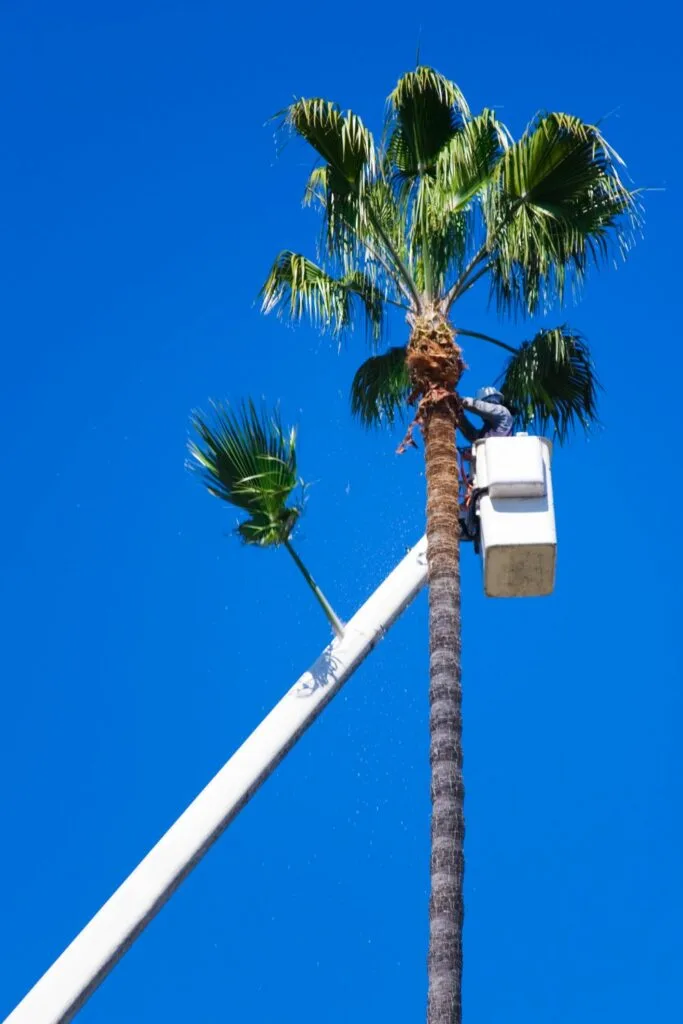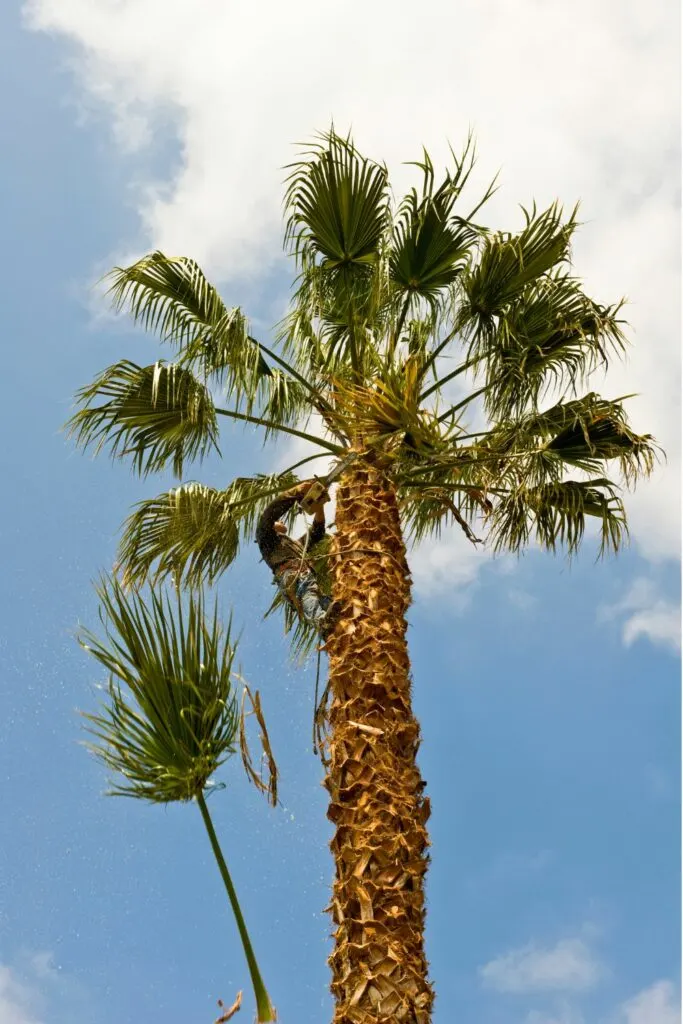Palm tree trimming is a valuable skill for any landscaper or homeowner living in a tropical environment. These trees not only provide aesthetic appeal but also offer shade and promote biodiversity.

Learning how to become a professional palm tree trimmer can lead to a fulfilling and potentially lucrative career, as tree trimmers and pruners earned an average wage of $44,040 per year as of May 2020.
Before embarking on your journey to becoming a palm tree trimmer, it’s essential to familiarize yourself with the necessary equipment and safety measures involved. A key step in the process is to sterilize your pruning tools, as this can prevent the spread of disease from one tree to another source. Furthermore, getting proper training or even seeking certification can make a difference in your success and safety while working in this profession.
By investing time in learning the proper techniques, understanding safety precautions, and acquiring professional training, you’ll be well on your way to becoming a respected and knowledgeable palm tree trimmer. With patience and dedication, you can develop a career that connects you with nature and provides countless opportunities for growth in the landscaping and tree care sectors.

Becoming a Palm Tree Trimmer
Palm tree trimming is an essential component of landscape and garden maintenance. In this section, we will discuss the steps to become a professional palm tree trimmer, including education, training, and certification requirements.
Education and Training
Although a formal education is not necessary to work as a palm tree trimmer, a strong foundation in gardening and landscaping is beneficial. You can gain this knowledge through various resources, such as online articles, blogs, and tutorials.
Many aspiring palm tree trimmers enroll in arboriculture or horticulture classes at a local community college or trade school. These courses often cover topics such as plant identification, tree biology, and proper pruning techniques.
Another way to gain valuable hands-on experience is through apprenticeships or on-the-job training. Working alongside an experienced arborist or tree trimmer can help you learn the nuances of the trade and develop your skills.
Certification and Requirements
Certification is a way to demonstrate your knowledge and credibility as a palm tree trimmer. The International Society of Arboriculture (ISA) offers several certifications, including the Certified Tree Worker designation. This certification requires a combination of work experience, a written exam, and a practical skills evaluation.
Another reputable organization in the field is the Tree Care Industry Association (TCIA), which offers accreditation and training programs for tree care companies. While individual certification is not typically provided by TCIA, being affiliated with an accredited company can enhance your professional reputation.
In addition to certification, some U.S. states may have specific licensing requirements for tree trimmers. Be sure to check your state’s regulations and adhere to any necessary guidelines.
Finally, always prioritize safety when working as a palm tree trimmer. Invest in proper protective gear, such as gloves, safety glasses, and a helmet. Utilize appropriate tools, like sterilized pruning shears or pole saws, and follow industry best practices, such as cutting fronds at least 2 inches away from the trunk to prevent pests and diseases.
By obtaining the right education, training, and certifications, you will be well on your way to becoming a skilled and competent palm tree trimmer.

Essential Skills and Equipment
Becoming a palm tree trimmer requires some essential skills and equipment to ensure safe and efficient work. In this section, we’ll discuss the basic tools and techniques, as well as safety and protective gear needed for this profession.
Basic Tools and Techniques
For a palm tree trimmer, having the right tools is vital to achieving clean and efficient pruning. Some of the basic tools and techniques you’ll need include:
- Pruning saw: This is a handy tool that can help you cut through thicker branches with ease.
- Pruners: These are essential for trimming smaller branches and maintaining a precise cut.
- Chainsaw: In some cases, a chainsaw may be necessary for removing large branches or cutting down an entire tree.
- Pole saw: As a palm tree trimmer, you will definitely need a pole saw to reach hard-to-reach spots, especially when dealing with trees that are more than 15 feet tall.
- Ladder: A sturdy ladder is crucial for safely reaching and cutting higher branches.
- Climbing equipment: Depending on the tree’s height and location, some jobs may require specialized climbing gear, such as ropes, harnesses, and carabiners.
Keep in mind that each job will require a slightly different approach, so being adaptable to different situations and honing your skills will help you become successful in this profession.
Safety and Protective Gear
Safety should always be a priority for palm tree trimmers. The use of proper safety equipment and protective gear can greatly minimize the risk of accidents and injuries. Some essential items include:
- Gardening gloves: These gloves will protect your hands from cuts, scrapes, and blisters while handling tools and branches.
- Climbing gear: As mentioned earlier, specialized climbing equipment is important for tree trimmers to ensure safety while working at heights.
- Cherry picker: In some cases, a cherry picker or similar lift equipment can be used to reach high branches while providing a more stable work platform than a ladder.
- Protective clothing: It’s important to wear long sleeves, long pants, and close-toed shoes when working as a tree trimmer in order to protect yourself from cuts, scratches, and insect bites.
- Helmet and goggles: Protecting your head and eyes is essential, especially when working around falling branches and sawdust.
By acquiring the essential skills and equipment mentioned above, you’ll be well-prepared to start your career as a palm tree trimmer. Remember to always prioritize safety and practice your techniques to become efficient and successful in your work.
Palm Tree Trimming Process and Best Practices
Inspecting and Preparing the Tree
Before you start trimming a palm tree, first inspect the tree for any signs of pest infestations, diseases, or damaged fronds. Look for dead or dying fronds that need to be removed, as well as any debris around the base of the tree. Next, make sure to gather all the necessary tools, including pruning shears, a serrated knife, garden gloves, and safety goggles. Ensure your pruning tools are sharp and properly disinfected before using them on the palm tree. Disinfecting tools can be done by using a solution of 1 part bleach to 3 parts water 1.
Proper Pruning Techniques
The primary focus when trimming palm trees should be to remove dead fronds while preserving the health of the tree. To avoid over-pruning, follow the Natural Cut or 9 to 3 Cut, where you trim only the dead fronds and leave all the green leaves untouched 2. When cutting, make sure to leave at least 2 inches from the trunk to prevent damage that may invite pests and diseases3. Use pruning shears for smaller cuts, or a serrated knife for larger, more fibrous fronds. Keep in mind that if you need to trim tall palm trees, it’s safer to call in a certified arborist, as attempting to climb a ladder while wielding pruning tools can be dangerous.
Managing Waste and Cleaning up
After trimming the palm tree, proper waste management and cleanup are crucial to maintain both the tree’s health and the aesthetics of your landscape. Collect the dead fronds, fruits, and flowers that have been removed in a suitable container—such as a heavy-duty trash bag or a wheelbarrow—for disposal. Depending on local regulations, you may be able to compost the waste material, take it to a designated waste management facility, or schedule a pickup from your local waste management service.
During the cleanup process, be sure to remove any additional debris or organic material from the base of the tree. This will help to minimize the chance of pests or diseases taking hold, and allow you to more easily monitor the health of the palm tree.
By following these best practices, you’ll not only improve the aesthetic appeal of your palm trees, but also contribute to their overall health and longevity.
Maintaining Palm Tree Health and Appearance
Watering and Fertilizing
Proper watering and fertilizing are crucial aspects of palm tree care. Palms require watering when the surface of the soil is dry, and it’s essential to deep water the tree until the soil is moist1. You typically want to provide enough water, about 10-20% of the container size, to prevent the leaves from turning brown and dry2.
Fertilizing your palm tree is another essential factor in maintaining its health and appearance. It’s best to use a slow-release fertilizer designed specifically for palms. Apply the fertilizer during the early spring to promote healthy growth.
Planting and Landscape Considerations
When planting palm trees, consider the landscape and the type of palm you want to grow. Some palms are better suited for small gardens or public parks, while others add diversity and visual appeal to more expansive landscapes. Ensure that you choose the right tree for your environment and provide adequate space for it to grow.
Tree maintenance is a necessary aspect of keeping your palm tree looking its best. In the early spring, use sterilized and sharpened trimming tools to remove dead or diseased branches and fronds3. Don’t forget to disinfect your tools using diluted bleach, alcohol, or a commercial disinfectant to prevent the spread of diseases4.
If you need to access the upper branches, use sturdy equipment like an extension ladder to safely reach the fronds4. Be cautious and ensure your safety when handling sharp tools at height.
In conclusion, maintaining palm tree health and appearance requires proper watering, fertilizing, planting, and landscape considerations. By following these guidelines and practicing regular tree maintenance, you can enjoy the beauty and benefits of a healthy, happy palm tree.
Addressing Palm Tree Issues
Palm tree trimming is an essential aspect of maintaining the health and appearance of these iconic tropical plants. In this section, we’ll cover a few key aspects of palm tree trimming, including responsible removal and fire hazards, and managing seeds, fruit, and flowers.
Responsible Removal and Fire Hazards
Dead fronds not only detract from the aesthetic appeal of your palm tree; they can also present a potential fire hazard, especially in regions prone to high winds and wildfires. Regular palm tree pruning eliminates this risk, keeping both the tree and its surroundings safe. Make sure to cut fronds at least 2 inches from the trunk, as this helps to prevent damage and the introduction of pests and diseases1.
Additionally, broken or dead fronds can obstruct visibility, potentially leading to accidents if they fall on roads, sidewalks, or walking paths. Regular trimming can help maintain clear lines of sight for the safety of those nearby.
Managing Seeds, Fruit, and Flowers
While palm trees are generally low maintenance, they do produce seeds, fruit, and flowers2. These can accumulate over time, leading to a mess on sidewalks and driveways, and unmanaged seeds can germinate and become a weed problem3.
To keep palm trees looking their best, it’s essential to remove seed and fruit stalks periodically, as well as trim any excess growth of flowers. This not only serves cosmetic purposes but also helps maintain the overall health of the tree. When trimming palm trees, observe the following basic rules4:
- Only trim brown fronds
- Remove flower stalks that are close to the trunk
- Address any potential pest or disease issues immediately
By diligently practicing these aspects of palm tree trimming, you can keep your tropical plant looking healthy and beautiful while ensuring the safety and well-being of the surrounding environment.
